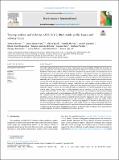Por favor, use este identificador para citar o enlazar a este item:
http://hdl.handle.net/10261/225880COMPARTIR / EXPORTAR:
 SHARE SHARE
 CORE
BASE CORE
BASE
|
|
| Visualizar otros formatos: MARC | Dublin Core | RDF | ORE | MODS | METS | DIDL | DATACITE | |

| Título: | Tracing surface and airborne SARS-CoV-2 RNA inside public buses and subway trains |
Autor: | Moreno, Teresa CSIC ORCID ; Pintó, Rosa María; Bosch, Albert; Moreno, Natalia CSIC ORCID ; Alastuey, Andrés CSIC ORCID; Minguillón, María Cruz CSIC ORCID ; Anfruns-Estrada, Eduard; Guix, Susana; Fuentes, Cristina; Buonanno, Giorgio; Stabile, Luca; Morawska, Lidia; Querol, Xavier CSIC ORCID | Palabras clave: | SARS-CoV-2 COVID-19 Disinfection Public transport Ozone RT-q PCR |
Fecha de publicación: | feb-2021 | Editor: | Elsevier BV | Citación: | Environment International 147: 106326 (2020) | Resumen: | Given the widespread concern but general lack of information over the possibility of SARS-CoV-2 infection in public transport, key issues such as passenger personal hygiene, efficient air circulation systems, and the effective disinfection of frequently touched surfaces need to be evaluated to educate the public and diminish the risk of viral transmission as we learn to live with the ongoing pandemic. In this context we report on a study involving the collection of 99 samples taken from inside Barcelona buses and subway trains in May to July 2020. From this sample group 82 (58 surface swabs, 9 air conditioning (a/c) filters, 3 a/c dust, 12 ambient air) were selected to be analysed by RT-PCR for traces of the SARS-CoV-2 virus. Thirty of these selected samples showed evidence for one or more of 3 target RNA gene regions specific for this virus (IP2, IP4, E). Most (24) of these 30 samples showed positivity for only 1 of the 3 RNA targets, 4 samples yielded 2 targets, and 2 samples provided evidence for all 3 targets. RNA remnants were more common in surface swabs from support bars (23 out of 58) than in ambient air inside the vehicles (3 out of 12), with relatively higher concentrations of viral RNA fragments in buses rather than in trains. Whereas subway train a/c filters examined were all virus-free, 4 of the 9 bus a/c filter/dust samples yielded evidence for viral RNA. After nocturnal maintenance and cleaning most buses initially yielding positive results subsequently showed elimination of the RT-PCR signal, although signs of viral RNA remained in 4 of 13 initially positive samples. The presence of such remnant viral traces however does not demonstrate infectivity, which in the present study is considered unlikely given the fragmentary nature of the gene targets detected. Nevertheless, best practice demands that close attention to ventilation systems and regular vehicle disinfection in public transport worldwide need to be rigorously applied to be effective at eliminating traces of the virus throughout the vehicle, especially at times when COVID-19 cases are peaking. Additionally, infectivity tests should be implemented to evaluate the efficiency of disinfection procedures to complement the information resulting from RT-PCR analysis. Modelling the probability of infection whilst travelling in buses under different scenarios indicates that forced ventilation greatly reduces the risk. | Versión del editor: | https://doi.org/10.1016/j.envint.2020.106326 | URI: | http://hdl.handle.net/10261/225880 | DOI: | 10.1016/j.envint.2020.106326 | ISSN: | 0160-4120 |
| Aparece en las colecciones: | (PTI Salud Global) Colección Especial COVID-19 (IDAEA) Artículos |
Ficheros en este ítem:
| Fichero | Descripción | Tamaño | Formato | |
|---|---|---|---|---|
| airborne_Moreno.pdf | 4,1 MB | Adobe PDF |  Visualizar/Abrir |
CORE Recommender
PubMed Central
Citations
70
checked on 28-mar-2024
SCOPUSTM
Citations
106
checked on 21-abr-2024
WEB OF SCIENCETM
Citations
92
checked on 28-feb-2024
Page view(s)
173
checked on 24-abr-2024
Download(s)
135
checked on 24-abr-2024

